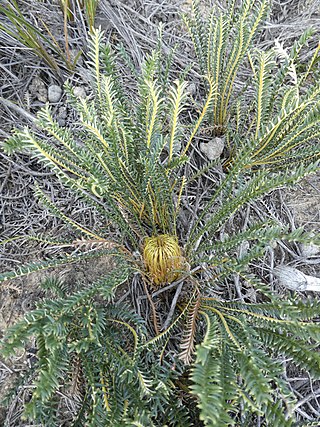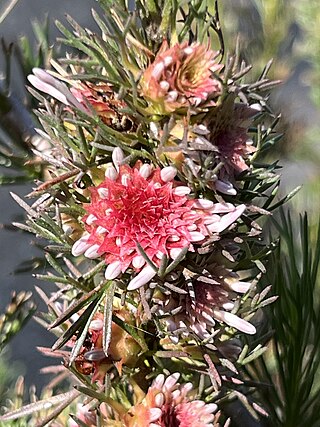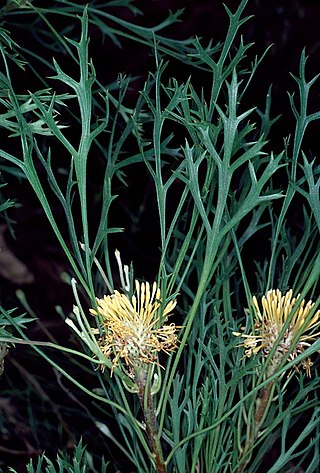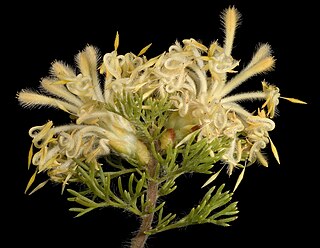
Banksia arctotidis is a species of prostrate shrub that is endemic to the southwest of Western Australia. It has leaves that are pinnately divided to the midrib, cream-coloured flowers and hairy, egg-shaped fruit.

Grevillea crithmifolia is a species of flowering plant in the family Proteaceae and is endemic to the south-west of Western Australia. It is a dense shrub with linear leaves, divided leaves with narrowly oblong lobes, or both, and clusters of pale pink to creamy-white flowers.

Isopogon dubius, commonly known as pincushion coneflower, is a species of plant in the family Proteaceae and is endemic to the south-west of Western Australia. It is a shrub with sharply-pointed, deeply lobed or pinnate leaves and more or less spherical heads of pink to reddish pink flowers.

Petrophile linearis, commonly known as pixie mops, is a species of flowering plant in the family Proteaceae and is endemic to southwestern Western Australia. It is a shrub with narrow egg-shaped leaves, the narrower end towards the base, and oval to spherical heads of hairy, greyish-pink or mauve to almost white flowers.

Petrophile macrostachya is a species of flowering plant in the family Proteaceae and is endemic to southwestern Western Australia. It is an erect shrub with prickly, pinnate or lobed leaves, and oblong or cylindrical heads of glabrous yellow to cream-coloured flowers.

Petrophile canescens, commonly known as conesticks, is a species of flowering plant in the family Proteaceae and is endemic to eastern Australia. It is an erect shrub with pinnately-divided leaves and oval heads of hairy, white to pale cream-coloured flowers.

Grevillea quercifolia, commonly known as the oak-leaf grevillea, is a species of flowering plant in the protea family and is endemic to the southwest of Western Australia. It is a straggly to sprawling shrub usually with pinnatifid or serrated leaves, and oval to cylindrical clusters of pale to deep pink flowers.

Isopogon asper is a species of plant in the family Proteaceae and is endemic to the south-west of Western Australia. It is a low shrub with crowded pinnate leaves and flattened spherical heads of glabrous pink flowers.

Isopogon baxteri, commonly known as the Stirling Range coneflower, is a species of plant in the family Proteaceae and is endemic to the south-west of Western Australia. It is an erect shrub with wedge-shaped, often 3-lobed, toothed leaves and flattened spherical heads of hairy pink flowers.

Isopogon divergens, commonly known as spreading coneflower, is a species of plant in the family Proteaceae and is endemic to the south-west of Western Australia. It is a shrub with pinnate leaves and more or less spherical heads of glabrous pink flowers followed by an oval to cylindrical fruiting cone.

Isopogon petiolaris is a species of plant in the family Proteaceae and is endemic to eastern Australia. It is a low, spreading shrub with sharply-pointed, divided leaves and more or less spherical heads of yellow flowers.

Isopogon uncinatus, commonly known as Albany cone bush, is a species of flowering plant in the family Proteaceae and is endemic to a restricted area near Albany in Western Australia. It is a small shrub with very short stems, linear to egg-shaped leaves with the narrower end towards the base, and spherical heads of yellowish flowers. It is the rarest isopogon and was thought to be extinct until rediscovered in the 1980s.

Petrophile anceps is a species of flowering plant in the family Proteaceae and is endemic to a restricted part of the south-west of Western Australia. It is a shrub with sharply-pointed, linear leaves and oval heads of hairy yellow flowers.
Petrophile crispata is a species of flowering plant in the family Proteaceae and is endemic to southwestern Western Australia. It is a shrub with pinnately-divided leaves with sharply-pointed tips, and oval heads of glabrous, yellow flowers.

Petrophile divaricata is a species of flowering plant in the family Proteaceae and is endemic to southwestern Western Australia. It is a shrub with bipinnate, sharply-pointed leaves, and oval to oblong heads of hairy, yellow flowers.

Petrophile ericifolia is a species of flowering plant in the family Proteaceae and is endemic to southwestern Western Australia. It is a shrub with cylindrical leaves, and oval to spherical heads of hairy, yellow flowers.

Petrophile media is a species of flowering plant in the family Proteaceae and is endemic to southwestern Western Australia. It is a low, spreading to erect shrub with needle-shaped leaves, and oval heads of hairy cream-coloured to yellow flowers.
Petrophile phylicoides is a species of flowering plant in the family Proteaceae and is endemic to southwestern Western Australia. It is a shrub with short, needle-shaped, but not sharply-pointed leaves, and more or less spherical heads of glabrous yellow flowers.

Petrophile serruriae is a species of flowering plant in the family Proteaceae and is endemic to southwestern Western Australia. It is a shrub with crowded, pinnate, needle-shaped, sharply-pointed leaves, and oval heads of silky-hairy yellow, greyish mauve to pink flowers.

Petrophile striata is a species of flowering plant in the family Proteaceae and is endemic to the south-west of Western Australia. It is a shrub with pinnate or bipinnate, striated, sharply-pointed leaves, and oval heads of silky-hairy yellow, creamy-yellow or cream-coloured flowers.



















